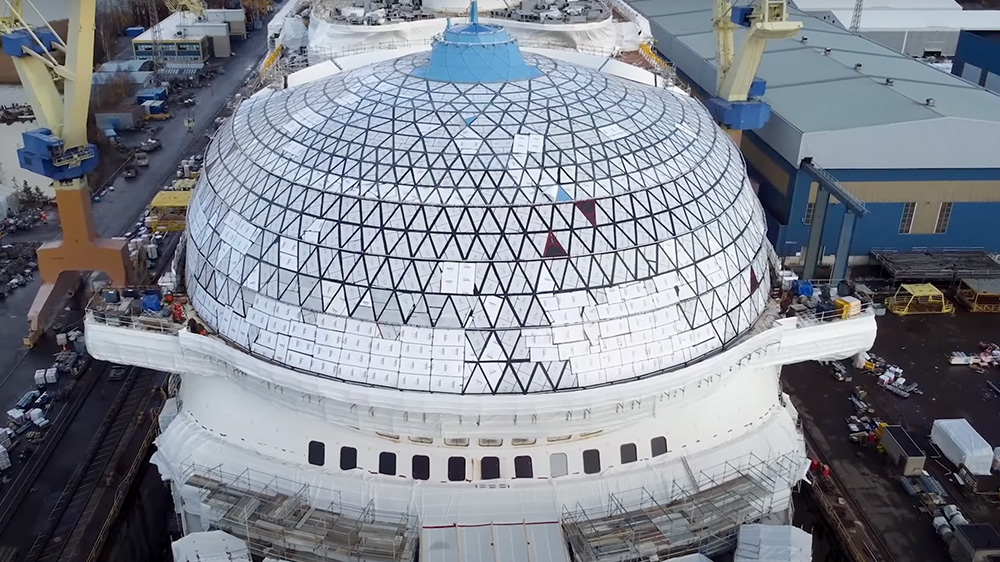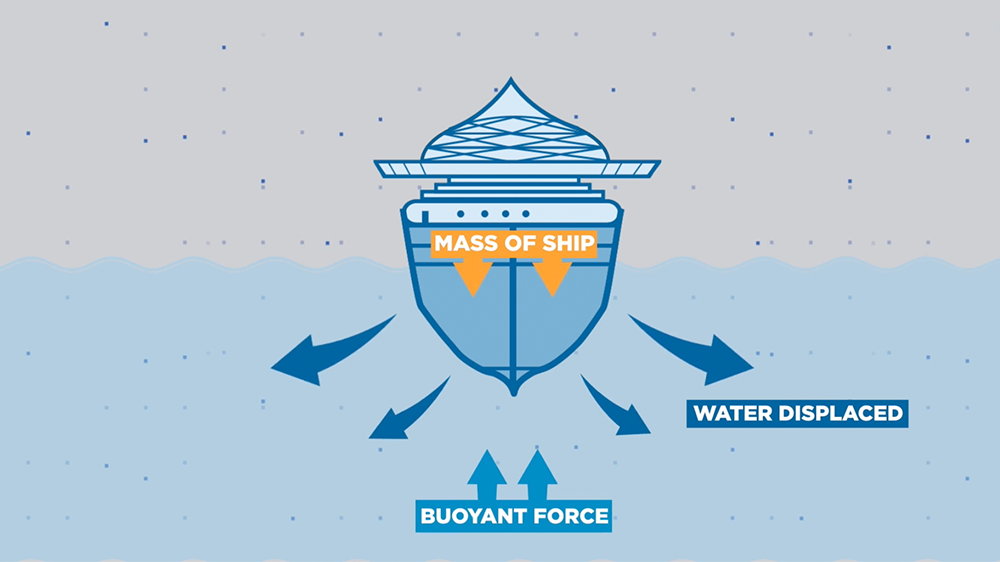Building the World’s Largest Cruise Ship
- Youtube Views 690,424 VIDEO VIEWS
Video narrated by Fred Mills. This video contains paid promotion for Bluebeam.
365 metres, 2,800 rooms, 250,000 gross tonnes, 22 elevators – this building is absolutely massive. And … it floats.
This isn’t some New York’s skyscraper. It’s the Icon of the Seas – the world's largest cruise ship. Forget the ideas of futuristic floating cities like in Korea or the Maldives. This one is happening right now.
If you thought building a structure on land was complex, try doing it on water.
There'll be 40 restaurants, a water park, eight distinct neighbourhoods and guests will be able to access their very own Central Park. At such a massive scale, it might as well be a skyscraper. It just happens to sail around the world with nearly 10,000 people on board.
This is how the world’s largest cruise ship was built.
![]()
Above: The Icon of the Seas undergoes sea trials. Image courtesy of Royal Caribbean.
Five times the size of the Titanic and 35 metres longer than the height of the Eiffel Tower … the Icon of the Seas is a HUGE ship to say the least.
It’s like if you took the Chrysler Building, laid it on its side and put it in the ocean. Except the boat is still 46 metres longer.
When it sets sail in 2024, the Icon of the Seas will take the title from the current largest operating ship, the Wonder of the Seas, by an additional three metres and two decks.
Construction has taken around 2.5 years to complete by Meyer-Turku Shipyard – one of Europe’s top shipbuilders in Turku, Finland.
But before construction even began, designs were first tested in Royal Caribbean’s high-tech innovation lab known as The Cave – a room-sized virtual reality simulator in Miami. Here, teams looked at renderings from all different angles before making any decisions.
Once the design was finalised, work in Finland’s shipyard could finally begin.
It all started with two long-standing maritime traditions: the steel-cutting ceremony, followed by the keel-laying ceremony.
Both occur in a dry dock – a sort of narrow basin that can later be filled with water. And the steel-cutting stage is when – you guessed it – the first bits of steel for the ship are cut.
Then during the keel-laying ceremony, the bottom parts of the actual ship are put into place. During the Icon’s ceremony, a 3,000-tonne crane was used to lift a massive steel block into the dock.
From there, the ship continued to build upwards.
Think of it as a giant lego set or game of Tetris. Engineers built parts of the ship – including the 2,800 staterooms – block-by-block in a separate location in the shipyard.
Each piece was then craned onto the dock where they are carefully stacked and welded into position working from the bottom up.
That’s different from how you build a skyscraper on land. While that does start from the foundation upwards, the vertical beams shape the entire building as the skeleton structure, followed by the interior and exterior finishings.
And while the outside of a skyscraper is usually covered in heavy materials like concrete, glass, or masonry, the Icon of the Seas is mostly made of extra-strength steel and curved sheet metal. Those materials are all much lighter.
One of the biggest challenges on the Icon was the Aquadome. A glass and steel structure that stands 25 metres tall and 50 metres wide and is the largest of its kind on any cruise ship.

Above: The Aquadome is a massive glass and steel structure on the front of the ship. Image courtesy of Royal Caribbean.
The higher a heavy piece like this sits on a ship, the more it affects stability and the centre of gravity. Engineers conducted several tests during the design process to ensure it could work.
To build it, 12 individual modules of steel, glass, and aluminium were assembled together. In total, the dome has 673 glass panels.
Once its rounded shape was finalised, a special rig with nearly 500 metres of suspension cable was used to move it onto the front of the ship. The final few metres of this move took more than six hours to complete. Then it was welded into place.
Over a period of eight months, the Icon continued to come together piece-by-piece until it was ready to be moved out of the dry dock and into an outfitting dock.
To do this, the dry dock was filled with water before five tugboats pulled the ship to the other part of the shipyard.
After a few more months of work, the ship underwent its first round of sea trials where everything from the engines to the steering system were put to the test in the water. The first trials lasted a few days and covered hundreds of kilometres. Another round will follow later in the year.
Now you may be thinking, how does a structure of this size actually float? And how does it operate? After all, it is essentially a massive skyscraper at sea.
Well according to the science of buoyancy, an object can float as long as the amount of water that is displaced is equal to its mass. The Icon may be big, but the ocean is infinitely bigger and there is a lot of open space on board that helps equalise its weight.

Above: An illustration of how buoyancy works.
Unlike skyscrapers which use a lot of concrete or masonry, the combination of steel and air on the ship helps creates buoyancy.
And inside the ship, interior design such as thin layers of marble finishings use less material than appear to the eye in order to maintain less weight.
But it really comes down to one important part of the ship that sits mostly underwater – the hull.
Typically, smaller boats have a V-shaped hull. This design helps vessels reach high speeds and cut through choppy waves with less stability.
Cruise ships instead have U-shaped hulls which are wider and rounder. This helps disperse weight and water more easily with their larger size. It also creates more space for amenities. And while it does cap speeds, it also provides more stability.
Skyscrapers take into account similar elements. When designing the core, the shape affects a building’s stability against wind. Instead of a traditional four-walls, taller buildings like the Burj Khalifa and Jeddah Tower use a Y-shaped three-walled core for further reinforcement.
You also might be wondering how to keep the lights on for nearly 10,000 people at sea. After all, this building can’t really connect to the electric grid out in the middle of nowhere.
Instead it relies on the Icon’s six multi-fuel engines. Unlike other Royal Caribbean ships that use diesel power, the Icon will rely on liquified natural gas. And in port, the ship saves energy by plugging into local power grids, rather than leaving the engine on and burning extra fuel.
So, now that we understand the basics, how big could a cruise ship actually get? And is there such a thing as ‘too big’?
![]()
Above: The Icon of the Seas under construction. Image courtesy of Royal Caribbean.
After all, the Icon has already been labelled as a ‘monstrosity’. And yet, it's set pre-booking records. So there’s clearly a market for building these massive structures at sea.
Even if engineers continue to solve the challenges of building on the water, not all ports can even accept a mega ship of such size.
And many have been banning mega ships due to port capacity, pollution and over-tourism.
So while the sky has been the limit for the height of many skyscrapers, the port size could be the limit for the size of future cruise ships. As we continue to push the bounds of engineering far into the sky on land – the future of cruise ship construction may not stretch so far into the water. Before we build the world’s next biggest cruise ship… first we might need to build a bigger port.
This video contains paid promotion for Bluebeam. Read about the creation of Royal Caribbean’s striking Miami HQ here.
Additional footage and images courtesy of Royal Caribbean.
We welcome you sharing our content to inspire others, but please be nice and play by our rules.








